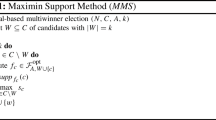Abstract
Firstly, in this paper, we analyze how the electors vote in the Senate election in Spain. We show examples in which the election outcome is predictable and not proportional. We also show similar examples for other social choice problems, in which the strategic vote affords a great advantage to those who put it into practice.
Secondly, we introduce the definition of a proportional social choice method. We then prove the main result that determines the only Borda type social choice method that has the same proportionality as a given divisor method.
We include results with the vote thresholds that guarantee the candidates will be elected under Limited Approval Voting and, finally, compare these thresholds with the proportional Borda Method.
Similar content being viewed by others
References
Balinski, M. L., & Young, H. P. (1982). Fair representation: Meeting the ideal of one man, one vote. New Haven: Yale University Press.
Brams, S. J. (1993). Approval voting and the good society. Political Economy of the Good Society Newsletter, 3(1), 10–14.
Brams, S. J., & Fishburn, P. C. (1983). Approval voting. Boston: Birkhäuser.
Carbó, S., Palomares, A., & Ramírez, V. (2004). La regulación de los organos de gobierno de las cajas de ahorros: Consideraciones electorales. Hacienda Pública Española, 171, 33–55.
Marín, L. (2003). Constitución Española. Aranzadi. http://www.congreso.es/funciones/constitucion/indice.htm
Palomares, A., & Ramírez, V. (2003). Thresholds of the divisor methods. Numerical Algorithms, 34, 405–415.
Ramírez, V. (2004). From principles of representation to the electoral methods. In Meeting on analysis and design of electoral systems. Oberwolfach, Germany.
Ramírez, V., & Palomares, A. (2002). Aspectos matemáticos en las elecciones a claustro Universitario de acuerdo con la LOU. Gaceta de la RSME, 5.3, 589–619.
Ramírez, V., Pérez, R., & Márquez, M. L. (1997). Distribución de los escaños del Senado por Comunidades Autónomas. Revista de las Cortes Generales, 41.
Saari, D. G. (1994). Geometry of voting. New York: Springer.
Saari, D. G. (2001). Chaotic elections!—A mathematician looks at voting. Providence: AMS.
Spanish electoral data, Congress and Senate. http://www.elecciones.mir.es/MIR/jsp/resultados/index.htm
Taylor, A. D. (1995). Mathematics and politics. New York: Springer.
Author information
Authors and Affiliations
Corresponding author
Rights and permissions
About this article
Cite this article
Ramírez, V., Palomares, A. The senatorial election in Spain. Proportional Borda methods for selecting several candidates. Ann Oper Res 158, 21–32 (2008). https://doi.org/10.1007/s10479-007-0250-9
Published:
Issue Date:
DOI: https://doi.org/10.1007/s10479-007-0250-9




